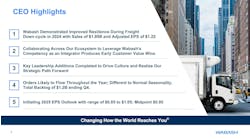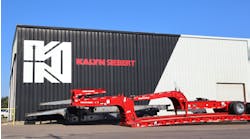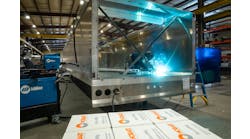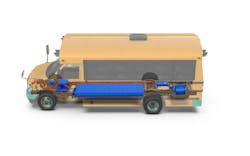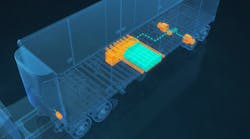While the excitement over commercial electric vehicles continues to grow, the supply of production vehicles is limited. Headline-grabbing startups are doing a good job of building interest, but they’re not building many EVs. And while legacy OEMs have a range of electric models available, supply chain challenges have slowed the assembly lines across the board—and small batches of EV orders aren’t a production priority when customers are clamoring for tried-and-true models.
Delivery delays are a serious matter for a commercial vehicle manufacturing company whose business is based on electrifying chassis made by someone else.
So Optimal EV, an established automotive engineering service company turned EV builder, worked with Fontaine Modification Work Truck & EV Solutions to develop a Plan B. With Ford E-450 cutaway chassis hard to come by, the answer was to bring in customers’ conventionally powered vehicles that are already in service and convert them.
The companies came up with a repower solution that seamlessly converts conventional gasoline- or diesel-powered trucks and buses to zero-emissions electric power.
Fontaine Modification’s longstanding reputation as a vehicle designer and integrator for the trucking industry’s OEMs has proved to be attractive to hopeful EV manufacturers.
“We have the opportunity to work with innovative companies, and they’re coming to us because they don’t know trucks and buses like we do,” David Brosky, vice president, sales and business development, at Fontaine Modification told TBB. “In the Optimal case, they’ve got a sound, highly engineered solution—so we don’t expect we’ll have to do much redesign work. As we launch, we’ll figure that out—but they’re in good shape right now, with the robustness of their technology.”
For the E1-R project, Fontaine will perform the repowers out of its modifications centers and will be building some new product as well, Brosky noted.
Fontaine Modification built more than 150 EVs for a range of customers last year and plans to build more than 1,000 units in 2023. To do that, Fontaine is expanding EV integration to six of its existing locations. The integrator also is launching two OEM glider programs this year.
“Not all existing trucks are candidates for repowers. We really need to work together because we don’t want [the vehicles] to be too old, and we don’t want to have to do too much—if any—refurbishing,” Brosky said. “That’s why we’ll target a good-sized fleet that has these vehicles that they can repower—not one or two, but 10, 15, 20 that we can do.”
Still, EV adoption is going to be incremental, Brosky noted, because the business case is “very challenging.” Yet battery technology, the “main driver” for EV success, is constantly improving and becoming less expensive.
“Now it’s about infrastructure for charging and it’s about affordability. You can’t do it on vouchers alone, and you can’t do it on just customers wanting to go green—there has to be a business case,” Brosky said. “That’s getting closer because the battery prices are coming down and extending the range. The total cost of ownership is actually coming in line with a traditional diesel or gasoline vehicle.”
Repower advantages
The new Optimal EV E1-R is built on the commonized Optimal Platform Technology and based on the Ford E-450 cutaway chassis. Fontaine will integrate the E1-R into a wide range of commercial vehicle applications including school buses, shuttle buses, delivery vans, and specialty vehicles at its network of post-production truck modification centers.
“We are excited to offer our customers another option allowing them to participate in the clean tech revolution that’s underway,” said Jason Hughes, senior vice president, business development at Optimal EV. “In fact, repowering existing vehicles is even a greener solution than first-sale examples, as the carbon emitted in the vehicle’s manufacturing process has already been accounted for. Repower also immediately offsets previously invested sunk costs. Add to that the fact that we are working with a world-class integrator like Fontaine, and it’s really a 360-degree win.”
The E1-R powertrain will be available on 2018 to 2023 model year Ford E-450 cutaway chassis. The system delivers 280kW/1700Nm (375hp/1254lb.-ft.), OEM E-450 equivalent 30% gradeability, and 125+ miles of range.
The powertrain features Proterra 113kW batteries and all power electronics and high voltage cables protected inside the vehicle’s frame rails.
Each conversion starts with a detailed vehicle inspection. The repowered vehicles are equipped with a new powertrain and user interface, with refreshed components where required.
The resulting repowered vehicle then reenters its fleet, essentially with the performance and longevity of a brand-new vehicle and the zero-emissions EV capability.
Combining Optimal EV’s more than 35 years of OEM-level engineering with Fontaine Modification’s nearly four decades of engineering, manufacturing, and system integration experience has resulted in a repower solution and conversion process designed to help accelerate electric fleet conversions.
The repowered vehicles will provide many commercial vehicle applications, including school buses, shuttle buses, delivery vehicles, and specialty vehicles, with zero-emissions performance, safety, and durability.
“The Optimal EV system design is simple and clean which allows for a robust and efficient integration,” said Brosky. “We’re looking forward to collaborating with the Optimal team to bring this repower solution to market.”
The first range of repower solutions are for the Ford E-450 cutaway chassis, which has long been widely modified by upfitters throughout North America. With the new E1-R, upfitters looking for new vehicles are getting a product they’ve already designed and planned for, but with an electric powertrain.
Plus, customers looking to repurpose existing vehicles have a new zero-emissions option.
From a sustainability perspective, repowering not only takes ICE vehicles off the road, but it also opens up a range of electric-drive solutions and options for truck upfitters and their customers, resulting in higher rates of EV adoption, less emissions, and better performing vehicles.
Same, but different
Fontaine Modification’s zero-emissions unit launched in 2019 and the aim, basically, has been to extend the company’s post-production expertise to the coming commercial vehicle generation, explained Mike Randolph, president of Fontaine Modification Work Truck & EV Solutions.
“It’s much more than just battery electric,” Randolph told TBB. “Yes, we’ve focused a lot on that—but the whole industry is changing. And what does Fontaine Modification do? We modify vehicles for customers’ unique needs, finishing those vehicles that are not mass-produced. The same mindset will be carried forward with any zero-emission vehicle.
“For example, how are you going to build an all-electric streetsweeper? How about the sewer suckers? How about a rolloff? A tow truck? The list goes on and on and on. So, we are gaining as much experience within this industry as we can, to position ourselves for future growth. It’s a traditional business for us, but it’s in a new environment, with new technology.”

